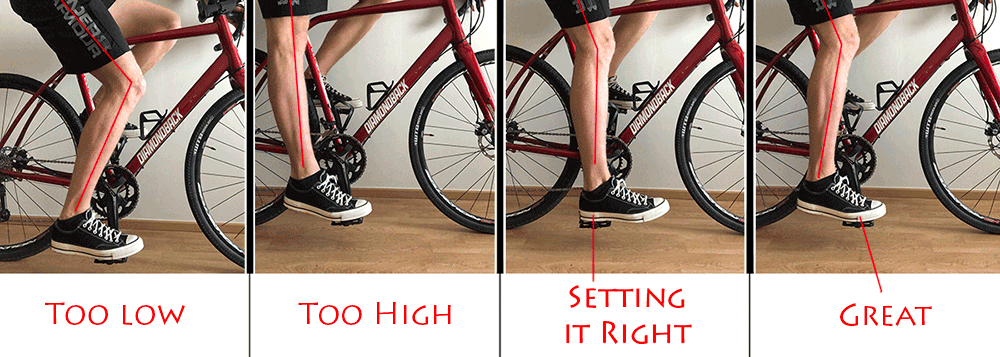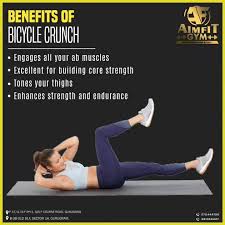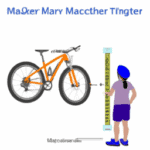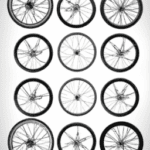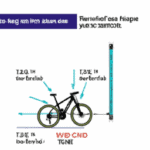If you’re on the taller side, a bike with a 28-inch frame would be ideal for you. Conversely, if you’re not as tall, opting for a 26-inch bike might be more appropriate. Additionally, the pedal propulsion mechanism in the 28-inch bike is more advantageous for those who are taller. However, you might be wondering which bike size is optimal for those who are shorter. Here are a few recommendations to assist in making your decision. Remember to also take into account both your body type and weight when selecting a bike.
Here are some general guidelines for choosing the right bike size based on your height:
| Size | Frame size | Notes |
|---|---|---|
| 4’11” – 5’3″ (150cm – 160cm) | 3″ – 15″ (XXS or XS) | For individuals in this height range, a bike with a frame size of 13″ – 15″ (XXS or XS) is typically recommended. |
| 5’4″ – 5’7″ (163cm – 170cm) | 15″ – 17″ (XS or S) | Individuals in this height range will typically fit well on a bike with a frame size of 15″ – 17″ (XS or S). |
| 5’8″ – 5’11” (173cm – 180cm) | 19″ – 21″ (L) | Individuals in this height range will typically fit well on a bike with a frame size of 19″ – 21″ (L). |
| 6’4″ and taller (193cm and above) | 21″ or larger (XL or XXL) | For individuals in this height range, a bike with a frame size of 21″ or larger (XL or XXL) is typically recommended. |
- 4’11” – 5’3″ (150cm – 160cm): For individuals in this height range, a bike with a frame size of 13″ – 15″ (XXS or XS) is typically recommended.
- 5’4″ – 5’7″ (163cm – 170cm): Individuals in this height range will typically fit well on a bike with a frame size of 15″ – 17″ (XS or S).
- 5’8″ – 5’11” (173cm – 180cm): For individuals in this height range, a bike with a frame size of 17″ – 19″ (M) is typically recommended.
- 6’0″ – 6’3″ (183cm – 191cm): Individuals in this height range will typically fit well on a bike with a frame size of 19″ – 21″ (L).
- 6’4″ and taller (193cm and above): For individuals in this height range, a bike with a frame size of 21″ or larger (XL or XXL) is typically recommended.
Bike Size Calculator (Flat Iron Bike)
Bike Size Calculator
These are general guidelines, and other factors like inseam length and riding style may also affect the best bike size for an individual. Visiting a local bike shop and getting a professional fitting is recommended to ensure that you choose the right bike size for your body and riding style.

28-Inch Bikes Are Ideal for Tall People
The size of a bike is an important factor to consider when purchasing one, because it largely depends on an individual's height. However, the size should be taken into consideration based on other factors, such as how you ride it. Here are some of the most common questions that people have about the size of a 28-inch bike:
The average person on a 28-inch bike is between 6'3" and 6'0". It is suitable for those who are over 183 cm. The most appealing feature of this bike is the comfortable sitting posture. A bike of this size is also easy to control and stable, making it an excellent choice for new adult cyclists. Listed below are some benefits of riding a 28-inch bike. And don't forget to check out the bike's height and leg inseam!
For the purpose of riding, a 26-inch bike is a good choice for people between 5'8" and 6'4" tall. It is more comfortable for shorter people, but can still be challenging for tall people. Nevertheless, this size has a lot of advantages for tall people. The size will also depend on your height and frame size. A 26-inch bicycle tire is 2.2 inches wide and is best suited for people below 170 cm.
Besides height, the inside leg measurement of a bike should be taken into account. This measurement is taken while standing with your legs shoulder-width apart. Measure from the ground to your crotch. Alternatively, you can mark the inside leg measurement of your leg on a wall. A 28-inch bike will fit most people with average leg length and height. This article is designed to help you select a bicycle that is right for your height.
26-Inch Bikes Are Better for Shorter People
In addition to being more comfortable for shorter riders, 26-inch wheels also help short people pedal faster. This is because smaller wheels are lighter and have less inertia, so you can use more energy to keep rolling. You can also get a better top speed from a 26-inch bike, which is good for city riding. Smaller wheels also feel less comfortable on bumpy surfaces. This is why people who are 5'5" or shorter should consider getting a bike with a 26-inch wheel.
To determine which bike size is right for you, take your height and inseam measurements. As a general rule, a bike frame should be at least 10 inches shorter than your leg inseam. A 26-inch bike will fit short people who are 5 feet tall, but a taller person will need a larger frame. To find the perfect size, use a size bike calculator.
Choosing the correct size bike is essential to improving your comfort. You'll want to make sure your bike has handlebars that are ergonomically designed to fit your hands. Also, it would be best if you chose a bike with a strong braking system to control movement at high speeds. A 26-inch bike will cost you anywhere from $100 to $1,000, depending on what you're looking for. If you're not sure, try riding a 26-inch bike first.
If you're short, a 26-inch bike is best for you. It's easier to pedal a 26-inch bike. You can also choose a smaller bike for a shorter person. There are models with larger wheels for taller riders, but they're not always the best choice for shorter riders. A 26-inch bike is a great option for children and teens who want to get out and explore on their bikes.
29-Inch Wheels Have Faster Acceleration
Bikers ask a common question: "Do 29-inch wheels have faster acceleration for what-size person?" In many cases, the answer is yes, but it depends on the riding style. A smaller rider may struggle to control a larger 29-inch wheel, while a taller person may find the bigger wheel size easier to control. This article will discuss the pros and cons of each wheel size.
The 29-inch wheel is typically heavier, which gives it a higher rolling inertia than a smaller one. A larger wheel will also require more expensive material to build, making it heavier overall. The bigger wheels are also more stable, which means the rider will experience less vibration when riding on them. But when it comes to acceleration, 29-inch wheels have the edge.
A smaller wheel may have a faster acceleration advantage, but the bigger wheel will provide a smoother ride and greater confidence when riding over obstacles. A 29er also provides increased stability, thanks to the longer wheelbase and lower bottom bracket. The bottom bracket is lower than the axle's centerline, creating a sense of riding inside the bike. That's a huge advantage for the average rider!
The benefits of 29-inch wheels are obvious. In certain areas of mountain biking, these wheels provide a better ride. The larger diameter and lower attack angle help riders roll over obstacles with less impact. As a result, 29-inch bikes provide smoother and less fatigued rides. This is particularly beneficial in areas with more steep terrain. If you're a taller rider, 29-inch wheels might not be for you.
26-Inch Wheels Are Better for Men's Mtb Frames
If you're a short guy, then you might want to avoid a men's MTB with 26-inch wheels. It might feel awkward on your shorter legs, but it will give you more space to move. Taller guys should go with a 26-inch bike. You might even be able to ride with a smaller 26-inch wheel if your frame size allows it.
Another thing to consider is your height. Taller riders tend to prefer big wheels. Although the wheel size is similar for a person of the same height, your height will likely vary from one person to the next. For instance, a 185-cm guy will want to go with a 26-inch wheel while a rider who's 165-cm tall might prefer a 29-inch wheel.
Compared to a 700c wheel, a 26-inch wheel will make your bike lighter and more maneuverable. While 27-inch wheels have the same performance as a 26-inch wheel, the 26-inch size will provide you with less weight. Besides, smaller wheels also use less material, making your bike lighter. Lastly, smaller wheels will have shorter spokes, which make them more durable and less likely to break.
In conclusion, choosing the right size for your frame is crucial. Generally speaking, 26-inch bikes are better for shorter people. People between 4'10 and 5'7 are good candidates for 26-inch bikes. They also have an adequate inseam range of 25-inches, or 63-76cm. However, depending on your height, you may need to change the frame size to accommodate your legs.
26-Inch Wheels Are Better for Children's Mtb Frames
If you're buying a child's bike, you might wonder whether 26-inch wheels are better for kids' MTB frames. The size of the wheels and frame are important, and the manufacturer should be able to tell you which size you should get. Similarly, the wheel size affects the overall performance of the bike, so a 26-inch bike might be just fine for smaller trails.
Children's bikes with 26-inch wheels are designed for younger and budget riders. The recommended rider height for 26-inch wheels is between 4'10" and 5'7". Gravity 2020 FSX 1.0 is a full-suspension mountain bike with name brand components. The Huffy Stone Mountain is a value-packed hardtail with 21-speed gears and rim brakes. It's perfect for tweens.
Age is not the best way to determine the size of a bike for a child, because kids of the same age often have different heights. Height is a more accurate way to determine a child's size. For example, a child between 58 and 63 inches tall would fit a 26-inch bike. To measure the right size, measure your child's inseam and match it with the height of the top tube of the bike.
While 26-inch wheels are the standard for kids' bikes, they're not the most versatile. Many adult bikes have large wheels, so choosing a child's bike with a smaller wheel size is not the best idea. The older bikes are better for kids than the new ones. When deciding which bike to buy, make sure to test it first to see how comfortable it is for the child.
